Honda Fit: Driving with the Paddle Shifters (Sport only)
Using the Paddle Shifters in D position (D-Paddle Shift Mode)
When you are driving in D position, you can shift the transmission up or down manually with the paddle shifters.
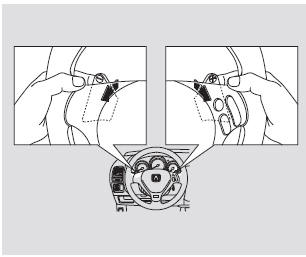
To shift up or down, use the + (right) or - (left) paddle shifter on each side of the steering wheel.
Each time you pull the + (right), the transmission shifts to a higher gear.
Pull the - (left) to downshift. You will see the selected gear number on the instrument panel.
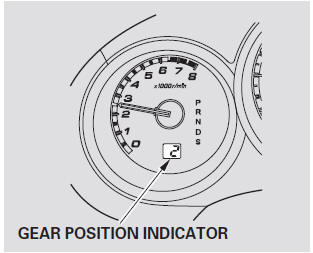
When you pull either paddle shifter, the gear position indicator shows you the selected gear number.
When the transmission returns to drive mode (D), the displayed gear number goes out.
Downshifting with the paddle shifter allows you to increase the engine braking when going down steep or long hills, and provides more power when climbing uphills. You can upshift the transmission manually to reduce the rpm. Driving in the higher gear helps fuel economy.
The transmission control system monitors the accelerator pedal use and your driving conditions. When you press the accelerator pedal as in normal driving, the system judges that you are driving at a constant cruising speed without using the paddle shifters. Under these conditions, D-paddle shift mode is canceled, and the transmission automatically returns to drive mode (D).
The transmission remains in the selected gear if you do not accelerate.
Each time you pull either paddle shifter, the transmission shifts one gear up or down. If you want to shift up or down more than two gears, pull the paddle shifter twice, pause, and then pull it again.
You cannot downshift with the paddle shifter before the engine speed reaches the upper limit of the lower gear. If you try to do this, the gear position indicator will flash the number of the lower gear several times, then return to a higher gear position.
Also, you cannot upshift with the paddle shifter before the engine speed reaches the lower limit of the higher gear.
The transmission downshifts to first gear and returns to drive mode (D) when the vehicle comes to a complete stop and the vehicle speed is about 6 mph (10 km/h).
If there is a problem in the transmission while you are driving with the paddle shifters, the D indicator flashes, the D-paddle shift mode is canceled, and the transmission returns to drive mode (D).
Using the Paddle Shift in S position (Sequential Shift Mode)
With the shift lever in S position, you can select the sequential shift mode to shift gears; much like a manual transmission using the paddle shifters, but without a clutch pedal.
To enter the sequential shift mode, press the release button on the front of the shift lever, move the lever to the S position, then pull either paddle shifter. To return to drive mode (D), move the shift lever to the D position.
While you are driving in the sequential shift mode, the transmission will not automatically return to drive mode (D).
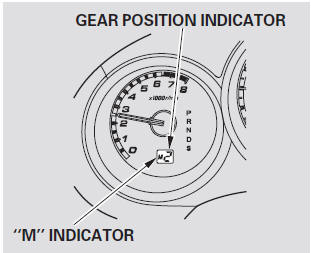
When you move the shift lever from ‘‘D’’ to ‘‘S’’ position and pull either paddle shifter, the gear position indicator displays on ‘‘M’’ along with the selected gear number.
To upshift, pull the + (right) paddle shifter. To downshift, pull the - (left) paddle shifter.
When you accelerate from a stop, the transmission starts in first gear, and you must manually upshift between first and fifth gears. Make sure you upshift before the engine speed reaches the tachometer’s red zone.
The transmission remains in the selected gear (5, 4, 3, 2, or 1). There is no automatic downshift when you push the accelerator pedal to the floor.
When you are driving in 4th or 5th gear, the transmission downshifts to the lower gear under the following conditions:
• The vehicle slows down to a certain speed.
• You press the brake pedal.
Downshifting gives you more power when climbing, and provides engine braking when going down a steep hill.
The transmission also shifts automatically as the vehicle comes to a complete stop. It downshifts to first gear when the vehicle speed reaches 6 mph (10 km/h) or less.
You cannot downshift with the paddle shifter before the engine speed reaches the upper limit of the lower gear. If you try to do this, the gear indicator will flash the number of the lower gear several times, then the indicator will display the higher gear number.
If the vehicle speed decreases below the redline of the selected lower gear while the indicator is flashing, the transmission downshifts, and the indicator displays the selected gear.
Here are the speed ranges for upshifting and downshifting.
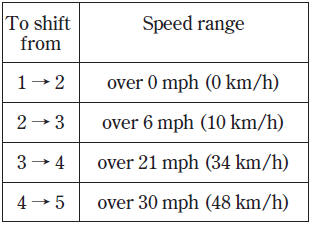
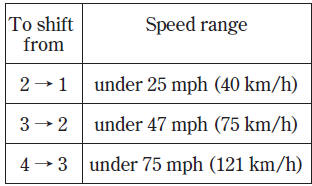
Starting in Second Gear
When you are in sequential shift mode, and the vehicle is stopped, pull the + (right) paddle shifter to shift to second gear. You will see ‘‘M 2’’ in the display. Starting in second gear helps to reduce wheelspin in deep snow or on a slippery surface.
See also:
Intermediate Shaft Reassembly (A/T)
Exploded View
Special Tools Required
Oil Seal Driver, 65 mm 07JAD-PL90100
Bearing Driver Attachment, 52 x 55 mm 07746-0010400
Bearing Driver Attachment, 35 mm I.D. 07746-0030400
Drive ...
Towing
If the vehicle needs to be towed, call a professional towing service. Never
tow the vehicle behind another vehicle with just a rope or chain. It is very
dangerous.
Emergency Towing -There are thr ...
Driving Preparation
Check the following items before you start driving.
Exterior Checks
• Make sure there are no obstructions on the windows, door mirrors, exterior
lights, or other parts of the vehicle.
► Re ...
